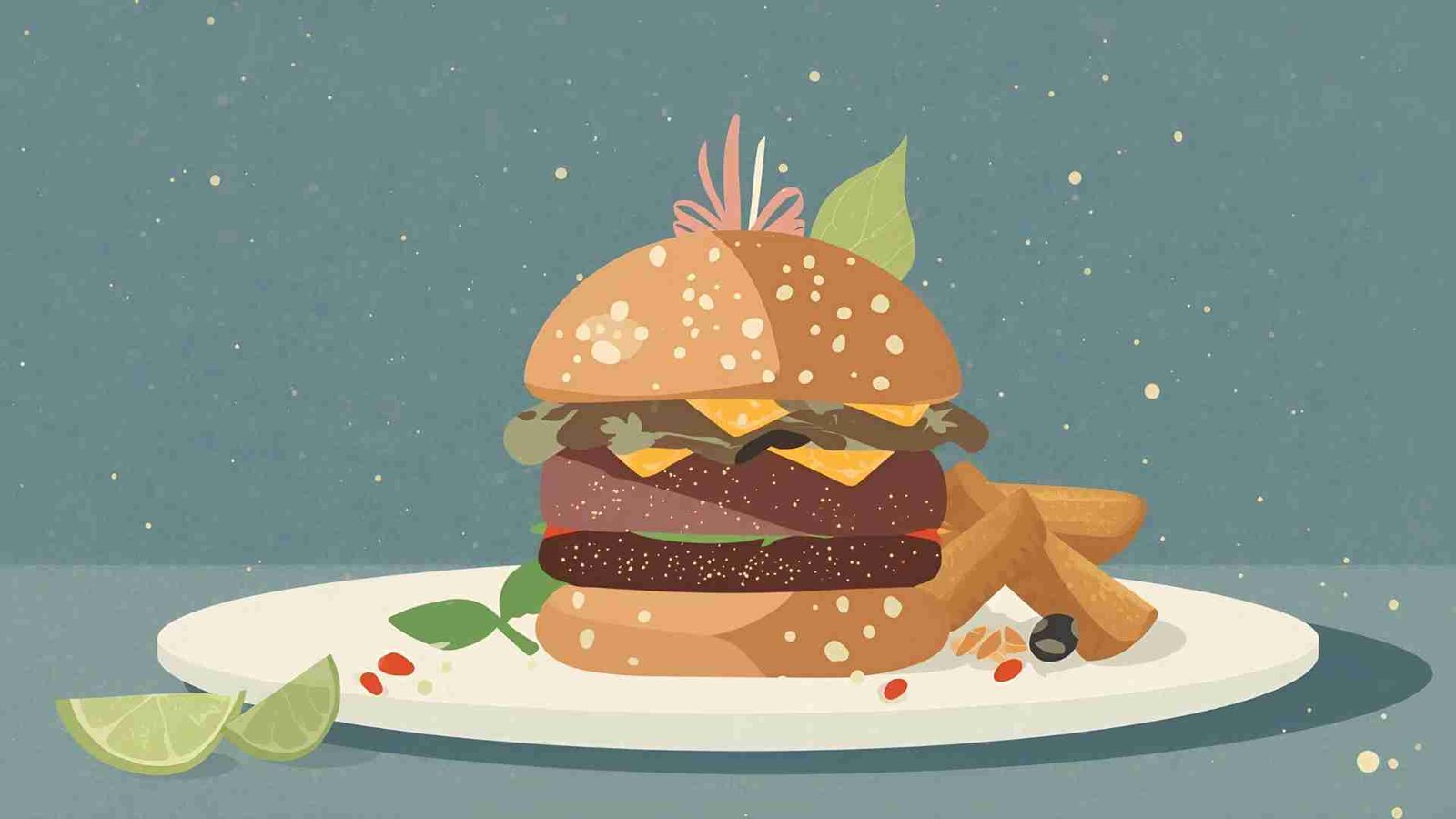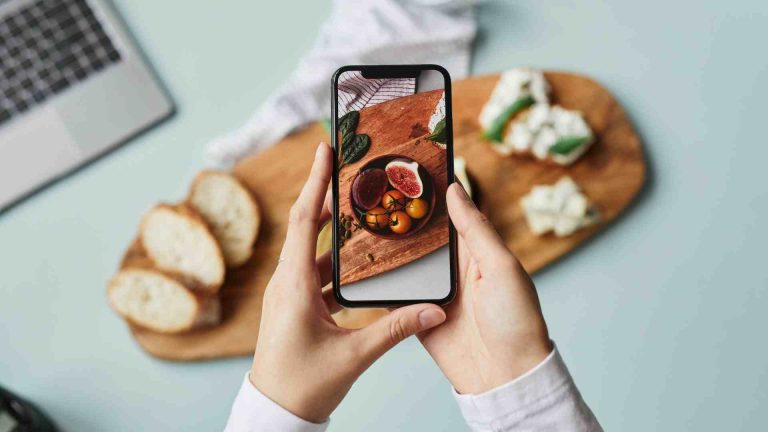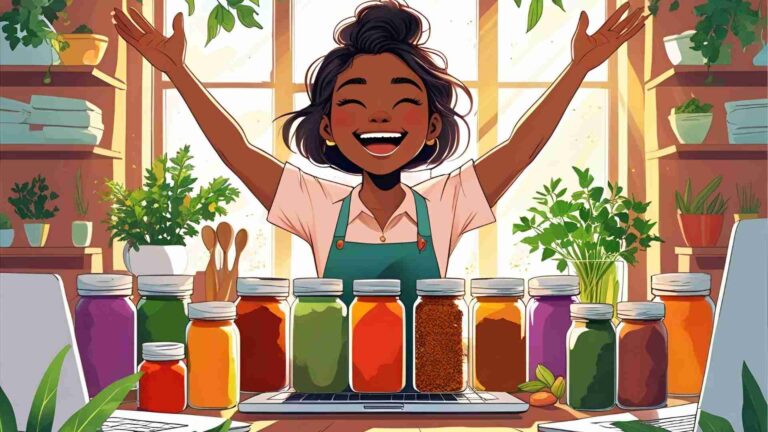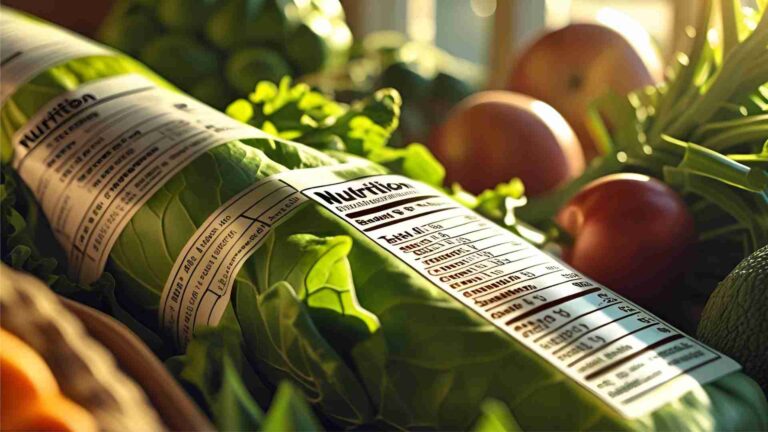How to use the Rule of Odds to improve your Food Photography
Introduction to Food Photography and Composition
Food photography is a captivating art form that combines creativity, technical skill, and storytelling to transform culinary creations into visually stunning images. Unlike other photography genres, food photography must evoke sensory experiences—making viewers not only see but also imagine the taste, texture, and aroma of the dish. At its core, composition is the backbone of impactful food photography. It determines how elements are arranged within the frame to guide the viewer’s eye and convey a narrative. Among the many composition techniques, the Rule of Odds stands out as a simple yet powerful method to enhance visual appeal, particularly in food photography where grouped subjects like fruits, desserts, or drinks are common.
The Rule of Odds suggests that an odd number of subjects—typically three, five, or seven—creates a more engaging and balanced composition compared to even numbers. This technique leverages human visual perception to produce dynamic images that feel natural and inviting. In this comprehensive guide, we’ll explore the Rule of Odds in depth: its principles, why it works, how to apply it in food and beverage photography, and how to integrate it with other techniques. We’ll also provide practical examples, tools, and tips to help photographers of all levels elevate their craft. Whether you’re shooting with a smartphone or a professional DSLR, this guide will equip you to create mouthwatering images that stand out.
Understanding the Rule of Odds
What Is the Rule of Odds?
The Rule of Odds is a composition principle that advocates for using an odd number of subjects in a frame to create a visually harmonious and engaging image. In food photography, this often applies to groups of items like cupcakes, fruits, or plates of pasta. For example, arranging three pies instead of two or four creates a more compelling scene. The rule is rooted in how our brains process visual information: odd numbers prevent the eye from pairing subjects symmetrically, which can make even-numbered compositions feel static or predictable.
In practice, the Rule of Odds is versatile and applies across photography genres, from landscapes to portraits, but it’s particularly effective in food photography due to the frequent use of grouped subjects. By using three, five, or seven items, photographers can craft images that feel intentional yet organic, mimicking the natural randomness found in everyday life—think of scattered berries on a dessert or a cluster of glasses on a table.
Why Does the Rule of Odds Work?
The effectiveness of the Rule of Odds lies in human psychology and visual perception. Our brains are wired to seek patterns and resolve visual information efficiently. When presented with an even number of subjects (e.g., two or four), the brain instinctively pairs them, creating a sense of symmetry that can feel overly structured or dull. In contrast, an odd number introduces a subtle imbalance that keeps the eye moving through the frame, creating a sense of flow and dynamism.
Research in visual arts and psychology supports this: odd-numbered compositions hold attention longer because they resist easy resolution. The unpaired subject—often the central “hero”—acts as a focal point, anchoring the viewer’s gaze while the surrounding elements guide exploration. In food photography, this translates to images that feel lively and inviting, encouraging viewers to linger and imagine the sensory experience of the dish.
For instance, consider a photo of three cookies on a plate. The middle cookie naturally draws attention, while the other two create a triangular flow, guiding the eye across the image. This setup feels more natural than four cookies, which might split into two pairs and divide attention. The Rule of Odds aligns with how we perceive beauty in nature—irregular yet harmonious—making it a go-to technique for creating appealing food photos.
Key Principles of the Rule of Odds
To apply the Rule of Odds effectively, consider these core principles:
- Select an Odd Number of Subjects: Choose three, five, or seven items for your composition. Three is the most accessible starting point, while five or seven add complexity without overwhelming the frame. Beyond seven, the brain perceives “many” rather than odd or even, reducing the rule’s impact.
- Establish a Focal Point: Designate one subject as the “hero” (e.g., a single pie with visible filling). Position it centrally or at a key point (like a rule-of-thirds intersection) to anchor the composition, with other subjects supporting it.
- Create Shapes for Visual Flow: Arrange subjects to form implied shapes, such as triangles or diagonals, to guide the eye. Triangles are particularly effective, as they create stability while encouraging movement.
- Balance with Context: Ensure supporting elements, like props or garnishes, complement the main subject without stealing focus. Props should enhance the story (e.g., flour for baking) and maintain odd groupings.
- Limit Overcrowding: Stick to smaller odd numbers to avoid clutter. Too many subjects can dilute the rule’s effectiveness and overwhelm the viewer.
Here’s a table summarizing the impact of odd vs. even compositions:
| Aspect | Odd Numbers (3, 5, 7) | Even Numbers (2, 4) |
|---|---|---|
| Visual Flow | Dynamic, eye moves naturally | Static, brain pairs subjects |
| Focal Point | Clear central anchor | Divided attention |
| Engagement | Higher, feels organic and natural | Lower, can feel predictable or staged |
| Best Use | Grouped foods (fruits, desserts, drinks) | Symmetrical or minimalist setups |
Planning Your Food Photography with the Rule of Odds
The Importance of Pre-Production
Successful food photography begins with planning. A well-thought-out composition ensures that every element in the frame serves the story, from the main dish to the props. The Rule of Odds thrives on intentionality, and sketching or pre-visualizing your shot helps you map out how to apply it effectively. A composition planning kit, which includes a rule-of-thirds or Phi Grid overlay, can streamline this process. These tools help you visualize subject placement, camera angles, and prop arrangements before you pick up your camera.
Steps for planning a Rule of Odds shoot:
- Identify the Hero Subject: Choose the main dish (e.g., a blueberry pie) that will anchor the composition.
- Select an Odd Number of Subjects: Decide on three, five, or seven items to feature. For example, three pies or five cocktails.
- Sketch the Composition: Use a planning kit to draw the arrangement, focusing on shapes like triangles or diagonals. Note the hero’s position and supporting elements.
- Incorporate Props: Add props (e.g., bowls, cutlery) that enhance the narrative but maintain odd groupings. Ensure props are contextually relevant (e.g., a rolling pin for pastry).
- Plan Lighting and Angles: Consider how light will interact with your subjects (e.g., backlighting for drinks) and choose a camera angle (0-45° or 90°) to highlight the odd arrangement.
Here’s a chart illustrating a three-subject triangular composition:
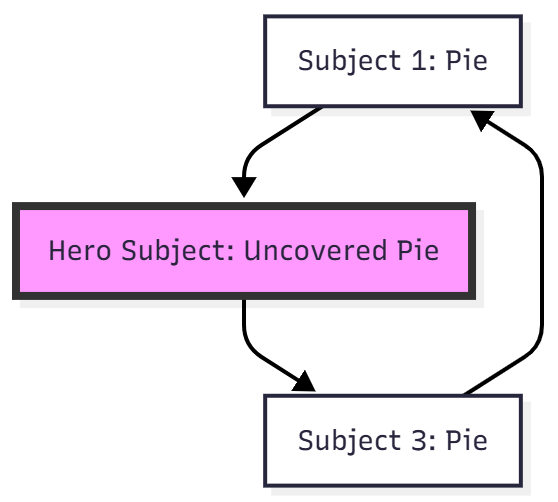
This diagram shows three pies arranged in a triangle, with the central pie as the focal point.
Tools for Planning
A composition planning kit is invaluable for beginners and professionals alike. You can create your own or download a pre-made one with a 3:2 aspect ratio and a rule-of-thirds grid. Digital tools like Adobe Photoshop (~$20/month subscription) or free apps like Canva allow you to sketch compositions. For physical planning, print a grid and use it to draft setups. Additionally, tethering software like Capture One Pro (~$299 or $20/month subscription) lets you view compositions in real-time, ensuring precise placement.
Practical Examples of the Rule of Odds in Food Photography
Example 1: Three Subjects (Blueberry Pies)
Setup: Arrange three blueberry pies in a horizontal line on a rule-of-thirds grid. Place the middle pie uncovered to showcase vibrant blueberries, making it the hero. Decorate the other two pies with odd-numbered garnishes (e.g., one sprig on one, three on the other), forming mini-triangles within the composition.
Why It Works: The horizontal line provides stability, while the triangles add interest. The uncovered pie draws the eye first, with garnishes guiding exploration. This setup is simple yet effective, ideal for beginners.
Visual Representation (Chart for three pies):
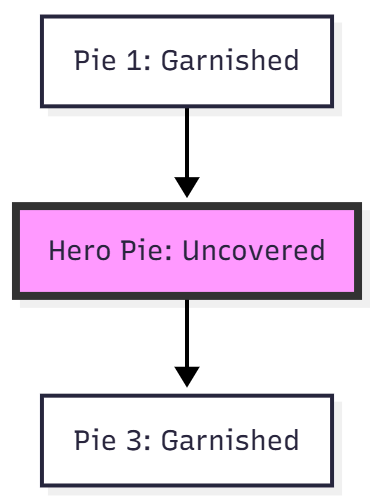
Final Image: The composition feels balanced, with the hero pie stealing the show while the others support it, creating a cohesive story of freshly baked pies.
Example 2: Five Subjects (Pies and Props)
Setup: Use three pies as main subjects, complemented by two props—a white bowl with flour and a tea strainer. Arrange in overlapping triangles, with the pies on the rule-of-thirds intersections and props at the edges. Add flour to the bowl to tie it to the baking theme.
Why It Works: The three pies maintain focus, while the props add context and depth. The triangular arrangement ensures dynamic flow, and the props’ odd-numbered garnishes (e.g., three berries near the bowl) reinforce the rule.
Visual Representation (Chart for five elements):
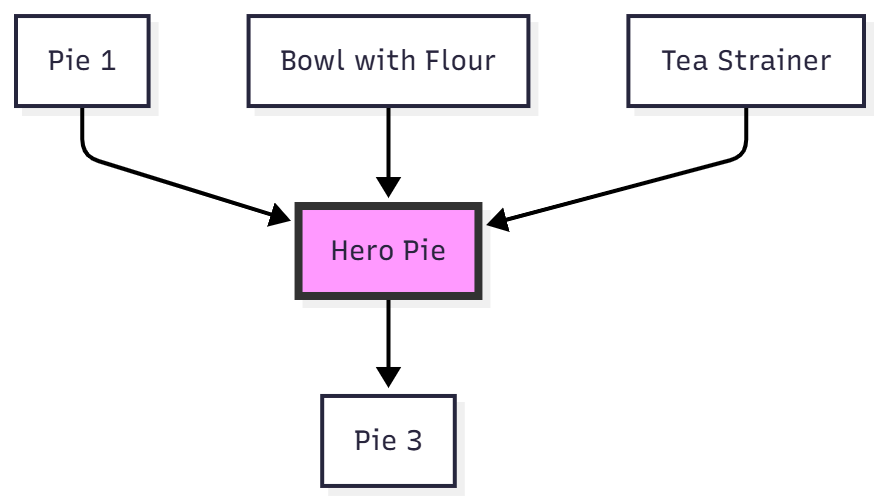
Final Image: The composition is richer, with props enhancing the narrative without overwhelming the pies.
Example 3: Seven Subjects (Pies and Bowls)
Setup: Include three pies and four bowls, arranged in a diagonal line with implied triangles. Place a sieve on a napkin in the corner as a leading line to the pies, reducing its prominence to keep focus on the hero pie.
Why It Works: The diagonal line adds energy, while multiple triangles maintain cohesion. The sieve guides the eye without competing, and the odd number ensures balance.
Visual Representation (Chart for seven elements):
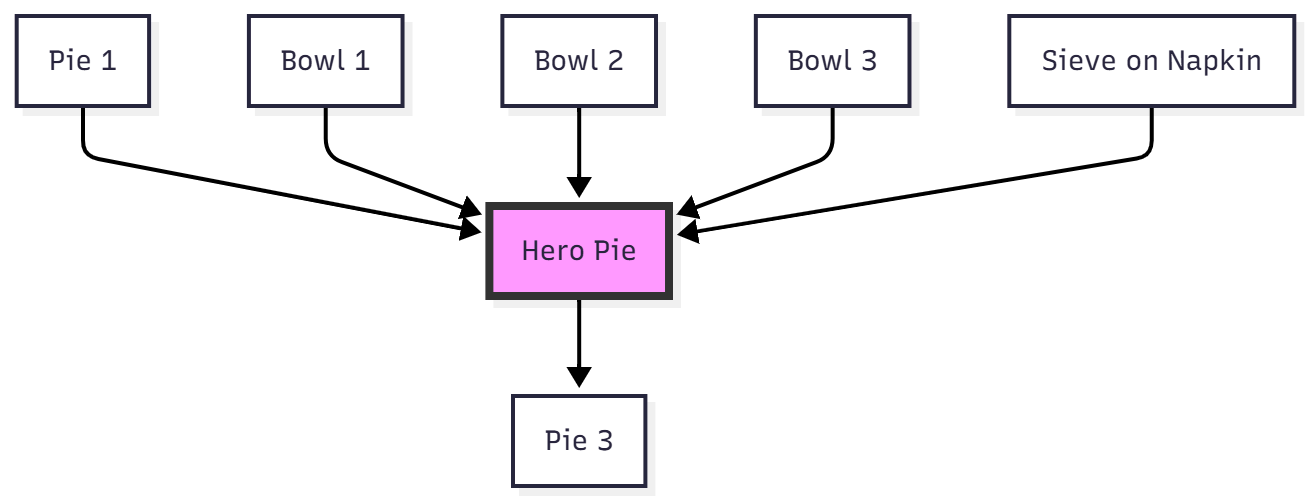
Final Image: A complex yet harmonious scene that tells a story of a bustling baking setup.
Integrating the Rule of Odds with Other Composition Techniques
To maximize the Rule of Odds’ impact, combine it with complementary techniques:
- Leading Lines: Use props like forks, spoons, or napkins to direct the eye toward odd-numbered subjects. For example, a spoon pointing to three glasses enhances flow.
- Negative Space: Surround odd subjects with empty space to emphasize them. A minimalist setup with three cupcakes on a bare table feels calm and focused.
- Layers and Depth: Position subjects at different distances (foreground, midground, background) and use a shallow depth of field (e.g., f/2.8–f/5.6) for bokeh, isolating the hero.
- Rule of Thirds or Phi Grid: Align odd subjects on grid intersections for balance. The Phi Grid, based on the Golden Ratio (1:1.618), offers a more natural flow than the rule-of-thirds.
- Framing: Use props like plates or cutting boards to frame odd subjects, adding focus and context.
Here’s a chart for combining the Rule of Odds with leading lines and framing:

Applying the Rule of Odds in Cocktail and Beverage Photography
Cocktail photography is a vibrant subset of food photography where the Rule of Odds excels. Drinks often appear one-dimensional, so odd-numbered arrangements add depth and interest.
Techniques for Cocktail Photography
- Arrange Odd Numbers: Place three or five glasses in a triangular or diagonal setup. For example, three cocktails with one in the foreground as the hero create a dynamic composition.
- Backlighting: Position the light source behind and slightly above drinks to avoid reflections. Use a reflector to softly illuminate the front. Recommended equipment: Godox AD200 Pro (~$349) for controlled lighting.
- Hard Light for Texture: Unlike soft light often used in food photography, hard light highlights glass textures, creating a prism effect. Position a light high and diagonally, adjusting distance for shadow length.
- Condensation Effect: Mix 50% water and 50% glycerin (~$10 for a 16oz bottle) in a spray bottle to create lasting condensation on glasses. This mimics a frosty, just-chilled look.
- Fake Ice Cubes: Use acrylic ice cubes (~$15 for 50) for staging, allowing pre-lighting without melting. For premium realism, Trengrove Ice (~$50 for 20) is ideal.
- Creative Garnishes: Add odd-numbered garnishes (e.g., three lemon slices) for color and texture. Dehydrate citrus or add sugar rims for detail.
- Complementary Colors: Use a color wheel to pair drinks with opposite hues (e.g., orange cocktails against a blue backdrop) for vibrancy.
Example: Three Cocktails
Arrange three cocktail glasses in a triangle, with the front glass as the hero. Use a blue backdrop to contrast an orange drink, backlit with a Godox SL-60W (~$139). Spray glycerin mix for condensation and add three dehydrated lemon slices. The odd number and triangular shape create a lively, balanced image.
Common Mistakes to Avoid
- Overcrowding: Too many subjects (e.g., nine or more) dilute the Rule of Odds’ impact, as the brain stops distinguishing odd from even. Stick to three or five for clarity.
- Ignoring Balance: Odd numbers alone don’t guarantee harmony. Uneven placement can create tension—use grids to ensure visual weight is distributed.
- Distracting Backgrounds: Busy backgrounds steal focus. Use a shallow depth of field or neutral backdrops (e.g., painted wood, ~$30 for a 4x4ft board) to keep attention on subjects.
- Inconsistent Props: Props must relate to the food story (e.g., flour for pies, not random objects). Irrelevant items disrupt the narrative.
When to Break the Rule of Odds
While powerful, the Rule of Odds isn’t universal. Break it in these scenarios:
- Symmetry for Calmness: Two subjects (e.g., mirrored plates) create a serene, balanced look, ideal for minimalist or architectural food shots.
- Single Subject for Impact: A lone dish with negative space emphasizes focus, like a single cake slice on a vast table.
- Even Numbers for Patterns: Four or six items (e.g., cookies in a grid) create rhythmic repetition, effective for graphic flatlays.
- Macro Shots: In close-ups of many items (e.g., scattered blueberries), odd/even distinctions become irrelevant.
Advanced Applications Across Photography Styles
The Rule of Odds extends beyond food photography:
- Portrait Photography: Pose three people in a triangle for dynamic group shots. For example, one person forward, two angled behind.
- Landscape Photography: Capture three rocks or five trees to guide the eye through vast scenes.
- Street Photography: Frame three pedestrians for spontaneity with structure.
- Still Life: Arrange five vases or three books for elegance and balance.
Tools for Advanced Application
- Tethering: Use Capture One Pro or Lightroom (~$10/month) with a Tether Tools USB cable (~$40) for real-time composition adjustments.
- Tripods: A Manfrotto 055 Aluminum Tripod (~$250) with an XPRO Magnesium Ball Head (~$150) ensures stability, especially for 90° overhead shots.
- Overlays: Create custom composition overlays in Photoshop or use pre-made ones (~$10 online) to guide placement.
Practical Tips for Beginners and Professionals
For Beginners
- Start Simple: Practice with three everyday items (e.g., apples). Experiment with angles and lighting.
- Use a Smartphone: Modern smartphones like the iPhone 14 Pro (~$999) or Samsung Galaxy S23 (~$799) offer excellent cameras for learning.
- Free Resources: Download composition grids from sites like Canva or create your own on graph paper.
- Practice Daily: Shoot odd-numbered setups at home (e.g., three mugs) to build intuition.
For Professionals
- Tethered Shooting: Use Capture One Pro with Live View to refine compositions instantly.
- Custom Backdrops: Invest in painted wood or canvas backdrops (~$50–$100) for texture and context.
- Client Collaboration: Request client moodboards or mock-ups to align Rule of Odds setups with branding needs.
- Editing: Use Luminar Neo (~$149/year) for subtle adjustments like selective brightening to emphasize odd subjects.
Enhancing Food Photography with Editing
Post-production enhances the Rule of Odds. Tools like Luminar Neo or Photoshop allow you to:
- Brighten the hero subject with selective masks.
- Blur backgrounds for negative space emphasis.
- Adjust colors to enhance complementary hues (e.g., boosting orange against blue).
- Crop to reinforce odd-numbered arrangements.
For example, in a three-pie shot, increase contrast on the hero pie and soften the background to highlight the triangular flow.
Equipment Recommendations and Pricing
| Equipment | Purpose | Price (Approx.) |
|---|---|---|
| Manfrotto 055 Aluminum Tripod | Stable camera positioning | $250 |
| Godox AD200 Pro | Versatile lighting for food/drinks | $349 |
| Godox SL-60W | Backlighting for beverages | $139 |
| Acrylic Ice Cubes (50 pieces) | Staging for drink photography | $15 |
| Glycerin (16oz bottle) | Condensation effect for glasses | $10 |
| Capture One Pro | Tethered shooting and editing | $299 (or $20/month) |
| Painted Wood Backdrop (4x4ft) | Textured background | $30–$100 |
| iPhone 14 Pro | Beginner-friendly camera | $999 |
Conclusion
The Rule of Odds is a transformative technique for food photography, offering a simple yet effective way to create balanced, dynamic, and engaging compositions. By arranging three, five, or seven subjects, you can guide the viewer’s eye, tell compelling stories, and evoke sensory experiences. Whether you’re capturing blueberry pies, cocktails, or minimalist desserts, this rule—combined with planning, complementary techniques, and thoughtful editing—elevates your work from ordinary to extraordinary.
Experiment with odd numbers, sketch your ideas, and don’t shy away from breaking the rule when symmetry or minimalism serves your vision. With practice and the right tools, the Rule of Odds will become second nature, helping you craft food photos that captivate and inspire. Start small, stay intentional, and watch your photography flourish.
Please share this How to use the Rule of Odds to improve your Food Photography with your friends and do a comment below about your feedback.
We will meet you on next article.
Until you can read, Cocktail Photography Tips for Food Photographers
